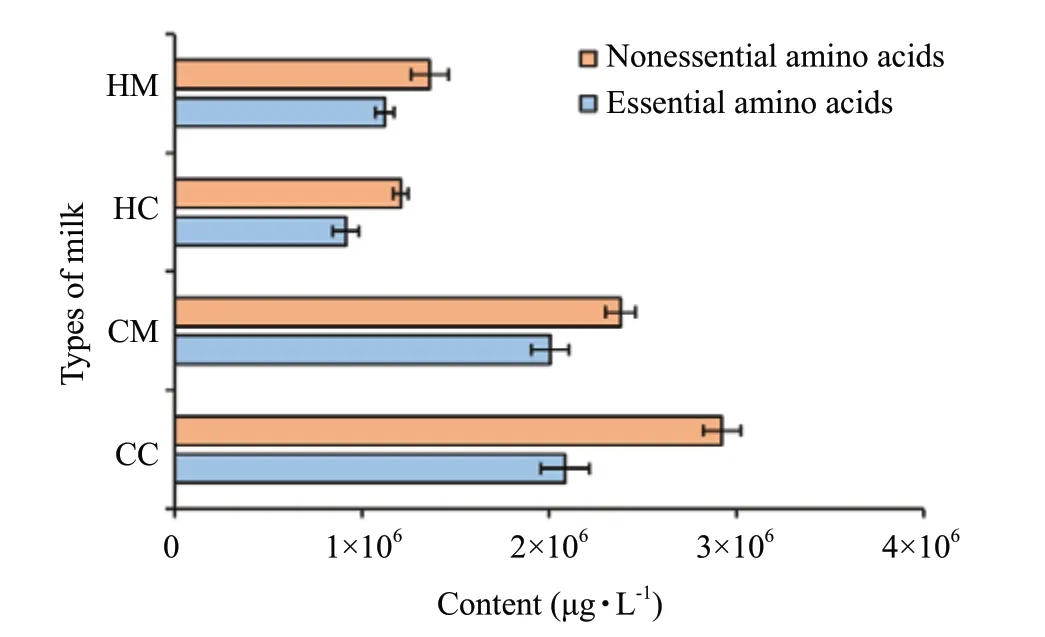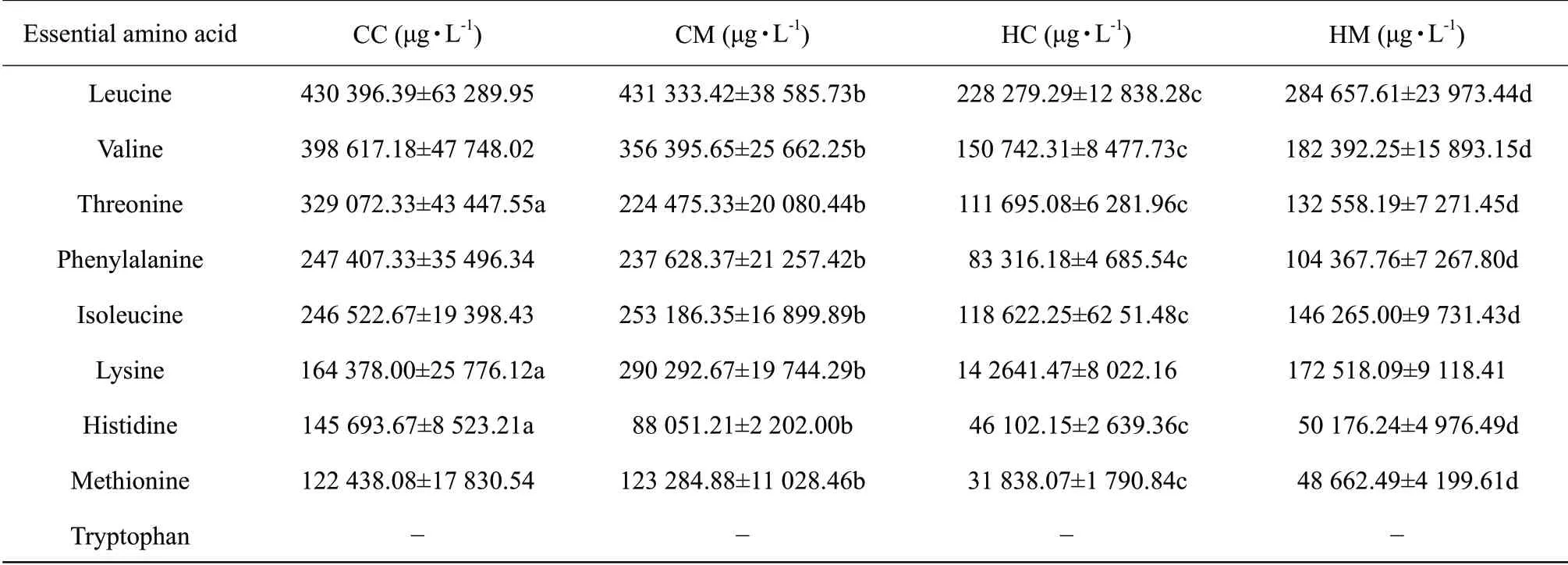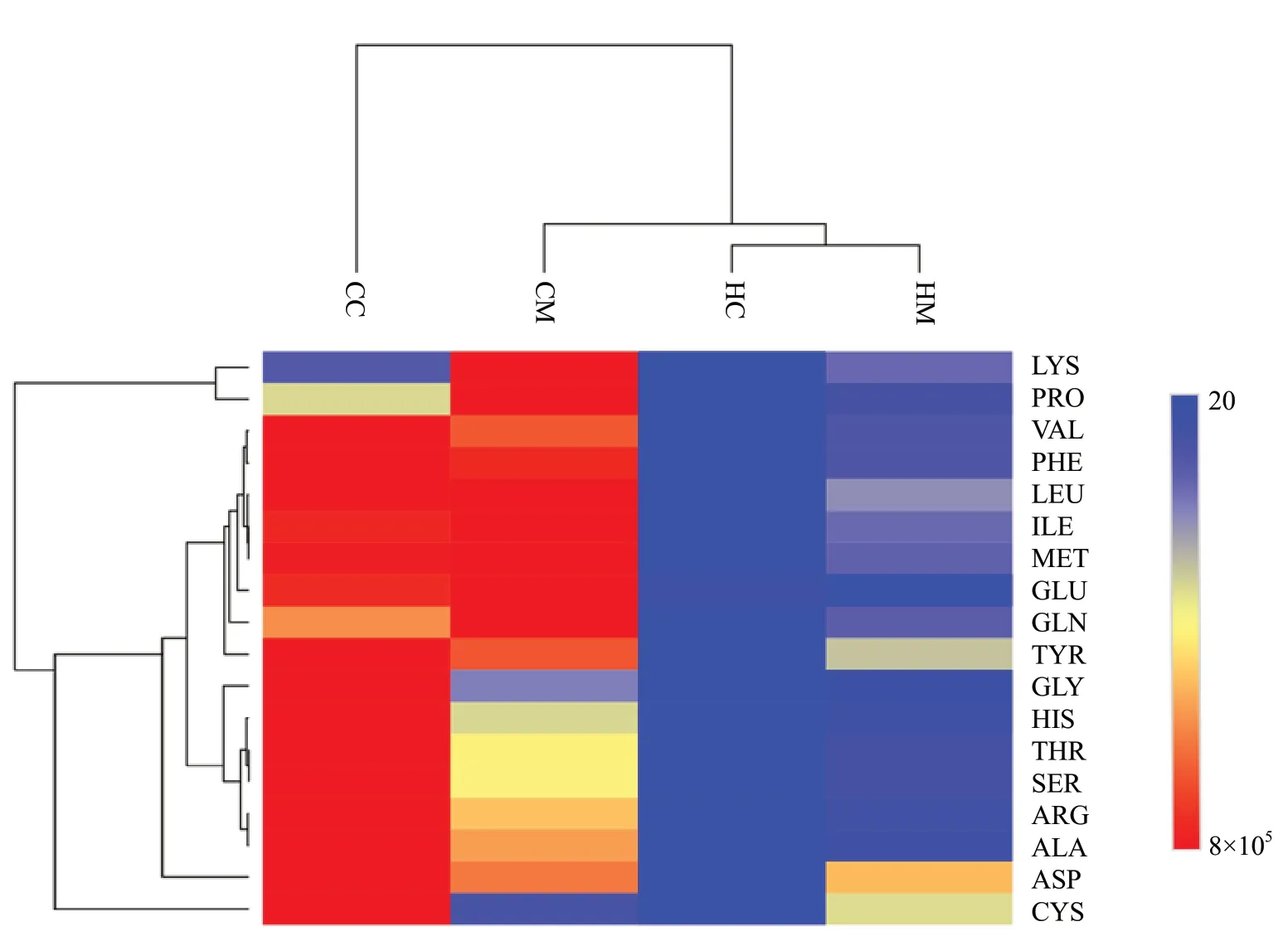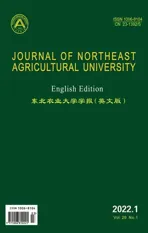Comparative Analysis of Hydrolytic Amino Acids in Human and Cow Milk of Different Lactation Periods
2022-04-06ZhangJuanChenJialiRayhnigulAbdllaLiMohanYuHaikunZhangXiuminZhengYanandYueXiqingCollegeofFoodScienceShenyangAgriculturalUniversityShenyang0866China
Zhang Juan, Chen Jia-li, Rayhnigul Abdlla, Li Mo-han, Yu Hai-kun, Zhang Xiu-min, Zheng Yan, and Yue Xi-qing* College of Food Science, Shenyang Agricultural University, Shenyang 0866, China
2 Beijing Academy of Food Sciences, Beijing100068, China
Abstract: In this study, the hydrolytic amino acids of Chinese human and Holstein cow milk of different lactation periods were analyzed by the advanced isobaric tags for relative and absolute quantitation (iTRAQ) combined with the high performance liquid chromatography-mass spectrometry (HPLC-MS/MS) approach. The total contents of the hydrolytic amino acids in cow colostrum, cow mature milk, human colostrum and human mature milk were 5.00, 4.38, 2.12 and 2.48 g • L-1, respectively. Among these, the contents of the hydrolytic amino acids in cow milk were higher than those in human milk, indicating a decreasing trend with the prolongation of lactation. Additionally, principal component and hierarchical cluster analyses were used to further screen the differentially expressed amino acids. These results enhanced the understanding of the hydrolytic amino acids in cow and human milk across different lactation periods, which could provide potential directions for newborn dairy powder and nutritious supplementary.
Key words: cow milk, human milk, lactation period, hydrolytic amino acid, iTRAQ, HPLC-MS/MS
Introduction
Milk, secreted by the mammary glands of mammals, is a significant nutritive substance which contains various biologically active ingredients, such as protein, fat, lactose, minerals and vitamin (Demmelmair and Koletzko, 2018). Milk is the ideal first food for the newborn and developing infants, not merely because of its essential nutritional value but also the quality that it is easily digested and absorbed by the body (Madadlou and Abbaspourrad, 2018). Generally, milk from 1 to 7 days postpartum is called colostrum, and milk after 15 days postpartum is called mature milk (Liet al., 2020a; 2020b). Since milk contains both essential nutrients that promote the development of the body and suitable ingredients for human physiological needs, it is of great concern as an ideal food (Caoet al., 2019; Liet al., 2019). With the conception and popularization of scientific breastfeeding concept, the comparative studies among cow and human milk have also received increasing attention (Haddeet al., 2015; Lianget al., 2018). However, there are still large differences of the nutritional components between cow and human milk (Yanget al., 2017b).
Amino acids, as the basic composition of the constituent proteins, have a close relationship with various life activities of the organism (Eriksenet al., 2018). According to the classification of nutrition, amino acids are divided into essential amino acids and nonessential amino acids (Tavareset al., 2018). Small molecule polypeptides or amino acids broken down from proteins are absorbed in the small intestine by the action of gastric acid and various digestive enzymes. Some amino acids are decomposed in the liver, or synthesized as new amino acids, and the other amino acids are directly transported into blood distribution to various organs, and then absorbed by the body (Unger and Holzgrabe, 2018). Additionally, the hydrolytic amino acids act a significant part in the connection between metabolites and proteomes, because the structure of the free amino acids is identical to the structure of the amino acids in proteins (Guet al., 2015). Therefore, the distribution of individual amino acids in different domains should be related to the biological state of biological system.
Isobaric tags for relative and absolute quantitation (iTRAQ) approach is usually used to mark specific amino moieties in peptides and compare proteins and the amino acids in different tissues after specific labeling (Ernoultet al., 2010). Compared with traditional methods, iTRAQ can achieve highthroughput detection and more simultaneous sample comparisons. Besides, short analysis time, high efficiency, extensive analysis range and accurate quantitative results are its other advantages (Kambirandaet al., 2013). High performance liquid chromatographymass spectrometry (HPLC-MS/MS) is a combination of high performance liquid chromatography and mass spectrometry (Renet al., 2015). It combines the abilities of efficiently isolating thermally unstable compounds and identifying components of a mass spectrometer (Weiet al., 2017).
In previous studies, the differences in the amino acids and proteins in human milk and cow milk during lactation are explored separately (Yanget al., 2016, 2017a; Liet al., 2019, 2020b). However, in-depth and systematic analysis of the hydrolytic amino acids in cow and human milk are relatively scarce and less comprehensive. The aim of this study was therefore to explore the hydrolytic amino acids compositions of cow and human milk across different lactation periods using the iTRAQ combined with the HPLCMS/MS and recent analytical methodologies. Principal component analysis (PCA) and hierarchical clustering analysis were used to indicate significant differences in cows and human milk of different lactations. The discrepancy in the hydrolytic amino acids provided more accurate and comprehensive guidance for infant milk powder production and functional dairy products.
Materials and Methods
Preparation of cow and human milk samples
Human milk samples were respectively denoted by 30 healthy and first-born mothers (20-35 years old) at a local Maternal and Child Hospital in Shenyang City, Liaoning Province. Fresh 30 Holsten milk samples were respectively collected from 30 healthy cows(1-5 years old) at a local farm in Shenyang City, Liaoning Province (123.59°E-41.93°N). In these milk samples, 15 samples were colostrum (0-5 days postpartum) and 15 samples were mature milk (15 days-6 months postpartum). Milk samples were immediately carried to the laboratory and frozen at −80℃ until analyzed. To reduce variation, 2 mL was removed from human and cow colostrum and mature milk, each sample was then mixed respectively. All the work was approved by relevant laws and institutional guidelines. The subjects consented to the study prior to participating donors.
Hydrolysis and iTRAQ labeling
First, removed 1 mL sample from each sample, placed into a clean centrifuge tube (1.5 mL), and added 1 mL of concentrated hydrochloric acid, mixed thoroughly with nitrogen gas, and incubated at 110℃ for 21 h. The reaction mixture was collected and centrifuged at 13 200×g for 4 min at 4℃. The supernatants were mixed, a 50 μL aliquot was removed and immediately dried with nitrogen, and 100 μL water was added. The acid hydrolysis solution (40 μL)was placed in a clean centrifuge tube (1.5 mL), 10 μL salicylic acid was added, and the mixture was centrifuged at 13 200×g for 4 min at 4℃. The supernatants were mixed, a 10 μL aliquot was transferred to a fresh centrifuge tube (1.5 mL), 40 μL buffer was added, and the mixture centrifuged at 13 200×g for 4 min at 4℃. The supernatants were collected and mixed again, 10 μL was removed and placed into another clean centrifuge tube (1.5 mL), and the mixture was abeled with 5 μL diluted the iTRAQ reagent. The collected samples were then mixed for 1 min and incubated for at least 30 min at 20℃ in the dark. Hydroxylamine (5 μL) was added to the centrifuge tube, followed by centrifugation at 13 200×g for 4 min at 4℃. Internal standard (32 μL) was then added to each centrifuge tube, which was centrifuged at 13 200×g for 4 min at 4℃. The derivatization samples obtained were collected and analyzed by the HPLCMS/MS.
Amino acid analysis by HPLC-MS/MS
Before being subjected to the HPLC-MS/MS analysis, the extracts were passed through a 0.22 μm reinforced nylon membrane filter purchased from Shanghai ANPEL (Shanghai City, China). The HPLC-MS/MS experiments were performed using an Ultimate 3000-API 3200 Q TRAP system equipped with an HPLC system and an MSLab HP-C18(4.6 mm×150 mm, 5 μm) column. The mobile phases consisted of the followings: a linear gradient (98%-0%) of solvent A (0.1% formic acid) in solvent B (acetonitrile with 1% formic acid) applied for 25 min, followed by 100% solvent B for 25 min. The HPLC operating conditions were as the followings: flow rate, 0.8 mL • min-1at 30℃; column temperature, 50℃; and injection sample volume, 3 μL. After the HPLC analysis, samples were subjected to MS. The operating conditions were as the followings: ion source, electrospray ionization in positive-ion mode; scan mode, multiple reaction monitoring; curtain gas 20 psi; collision gas, medium; ion spray, +5 500 V; ion-source temperature, 500℃; nebulizing gas, 55 psi; drying gas, 60 psi; declustering potential, 35 V; entrance potential, 10 V; collision energy, 30 eV; and collision cell exit potential, 5.0 V. For improved analytic accuracy, all the samples were accurately weighed, extracted three times, analyzed in triplicate, and then dissolved in diluted formic acid to the appropriate concentrations. The mean values and standard deviation (SD) were obtained from the three technical replicates.
Statistical analysis
Principal component analysis (PCA) was used to examine amino acid contents between cow and human colostrum using Unscrambler software (v9.8; Camo Software, Oslo, Norway). To assess significant differences in the amino acids, data were subjected to independentttests, and the results were presented as means plus/minus SD. The data were analyzed using SPSS software (v17.0; SPSS, Inc., Chicago, IL, USA), and differences were considered significant atP<0.05.
Results
Comparison of the total hydrolytic amino acids in cow and human milk of different lactation periods
In this study, 20 kinds of the hydrolytic amino acids from cow and human milk of different lactations were identified and quantified by the iTRAQ combined with the HPLC-MS/MS approach. The total contents of the hydrolytic amino acids in cow colostrum, cow mature milk, human colostrum and human mature milk were 5.00, 4.38, 2.12 and 2.48 g • L-1, respectively. As shown in Fig. 1, the contents of the hydrolytic essential and nonessential amino acids in cow milk were significantly higher than those in human milk. From the perspective of lactation, the contents of the hydrolytic essential and nonessential amino acids in human milk increased with the prolongation of lactation. Additionally, the hydrolytic essential amino acids in cow milk did not change significantly with the prolongation of lactation, while the hydrolytic nonessential amino acids showed a downward trend with the extend of lactation conversely. Tryptophan and asparagine were not detected in any types of milk, probably because the structure of the basic amino acids was destroyed during the acid hydrolysis process (Liet al., 2019). These results demonstrated that there were significant differences in the contents between cow and human milk across different lactation periods.

Fig. 1 Contents of the total hydrolytic amino acids in cow colostrum (CC), cow mature milk (CM), human colostrum (HC) and human mature milk (HM)
Comparison of hydrolytic essential amino acids in cow and human milk of different lactation periods
All the 20 kinds of the hydrolytic amino acids were classified into essential and nonessential amino acids. The total contents of the hydrolytic essential amino acids in cow colostrum, cow mature milk, human colostrum and human mature milk were 2.08, 2.00, 0.91 and 1.12 g • L-1, respectively. Data from Table 1 suggested that histidine and threonine contents were significantly higher in cow colostrum relative to those in cow mature milk (P<0.05). By contrast, lysine content was significantly higher in cow mature milk than that in cow colostrum (P<0.05). Although there was no significant difference in histidine content, significant differences were observed in the contents of the seven other hydrolytic essential amino acids between human colostrum and mature milk (P<0.05). It could be seen from Table 1 that the seven hydrolytic essential amino acids except lysine were significantly higher in cow colostrum than those in human colostrum (P<0.05). It could be observed that the leucine content was the highest in the hydrolytic essential amino acids. In addition, the content of threonine in cow mature milk was about 2.5 times as high as that in human mature milk. Histidine, isoleucine, phenylalanine and valine were about twice as much as those of human mature milk. Except for tryptophan, there were significant differences in the contents of other eight hydrolytic essential amino acids between cow and human mature milk (P<0.05).

Table 1 Contents of hydrolytic essential amino acid in cow colostrum (CC), cow mature milk (CM), human colostrum (HC) and human mature milk (HM)
Comparison of nonessential hydrolytic amino acids in cow and human milk of different lactation periods
The total contents of the hydrolytic nonessential amino acids in cow colostrum, cow mature milk, human colostrum and human mature milk were 2.92, 2.38, 1.21 and 1.36 g • L-1, respectively. Data from Table 2 demonstrated that the contents of arginine, glycine, serine, cysteine and alanine in cow colostrum were significantly higher than those of cow mature milk (P<0.05). Conversely, the proline contents were significantly lower than those of cow mature milk (P<0.05). The contents of glycine in cow colostrum were nearly 2 times higher than those of cow mature milk. Both human colostrum and mature milk contained 10 nonessential amino acids other than asparagine. The contents of serine, tyrosine, aspartic acid and cysteine in human mature milk were significantly higher than those in human colostrum (P<0.05). Among these, the contents of aspartic acid and cysteine in human milk were about 1.5 times as high as those in human colostrum. Overall, with the exception of proline, the contents of the hydrolytic amino acids were significantly higher in cow colostrum than those in human colostrum (P<0.05). The contents of the hydrolytic amino acids in cow colostrum and human colostrum were quite different. Among them, the contents of glycine, arginine and serine in cow colostrum were about 8, 4, 3 times as high as those in human colostrum, respectively. In addition, the contents of glutamic acid in both cow and human colostrum were high, and the contents of glutamic acid in cow colostrum were approximately twice those in human colostrum. Except for asparagine, which was not found in either cow or human colostrum, and no significant difference was observed in aspartic acid and cysteine, the contents of other eight nonessential amino acids were higher in cow mature milk relative to those in human mature milk (P<0.05). Additionally, the contents of arginine, glycine, serine and glutamate were two fold higher in cow mature milk than those in human mature milk. The above four kinds of amino acids could all play roles in accelerating the metabolism of the human body, improving the function of the human body, and also serving as a functional substance of the brain (Fernstrom, 2005; Liet al., 2007). Therefore, the unique physiological function of cow milk compared to human milk might be related to the above four amino acids.

Table 2 Contents of hydrolytic nonessential amino acids in cow colostrum (CC), cow mature milk (CM), human colostrum (HC) and human mature milk (HM)
Principal component analysis of quantified amino acids in cow and human milk
The PCA was performed to evaluate the effect of parameters in the classification and differentiation of the four groups (cow colostrum, cow mature milk, human colostrum and human mature milk). The PCA results are shown in Fig. 2. A total of 96.977% of the difference was explained by the relation between principal component 1 (PC1) and principal component 2 (PC2). The PC1 was responsible for 80.054%,while PC2 was responsible for 16.923 % of the difference. The PCA visualized the differentiation among the four groups. Cow mature milk scored the highest in the PCA (PC1+PC2), followed by cow colostrum, human mature milk and human colostrum. Regarding the distribution of parameters, the contents of leucine, valine, threonine, phenylalanine, lysine, histidine, methionine, glutamic acid, glycine, serine, arginine, aspartic acid, alanine, cysteine and glutamine were responsible for the separation of the PC1. These parameters were concentrated in the cow colostrum. Furthermore, the contents of the ILE, the TYR and the PRO were responsible for the separation of the PC2. These parameters were concentrated in cow mature milk.

Fig. 2 Principal component analysis of amino acids from cow and human colostrumTHR, Threonine; ALA, Alanine; CYS, Cysteine; ASP, Aspartic acid; SER, Serine; MET, Methionine; PHE, Phenylalanine; GLN, Glutamine; ILE, Isoleucine; GLU, Glutamic acid; ARG, Arginine; LEU, Leucine; LYS, Lysine; TYR, Tyrosine; TRP, Tryptophan; PRO, Proline; VAL, Valine; ASN, Asparagine; HIS, Histidine; GLY, Glycine.
Cluster analysis of quantified amino acids in cow and human milk
Hierarchical clustering analysis was performed on the 20 quantified and differentially expressed amino acids were conducted using open-source Cluster 3.0 software. Many amino acids shared clustering similarities; however, there were some significant differences found between cow and human milk. Eight hydrolytic amino acids in cow mature milk exhibited upregulated levels relative to cow colostrum, whereas 11 hydrolytic amino acids in human colostrum exhibited upregulated levels relative to human mature milk.
Differences in other differentially expressed amino acids between cow and human colostrum are shown in the heat map in Fig. 3. Using of multivariate statistical methods to assess variations in the amino acid levels was novel in the amino acids researches; therefore, this data would increase the understanding of differences in the amino acid distribution between cow and human colostrum and provide valuable insight into possible strategies for the amino acid supple mentation for infants and boosting the production of functional dairy products.

Fig. 3 Hierarchical clustering of differentially expressed hydrolytic amino acids in cow colostrum (CC), cow mature milk (CM), human colostrum (HC) and human mature milk (HM)
Discussion
The results suggested that histidine and threonine contents were significantly higher in cow colostrum relative to those in cow mature milk (P<0.05). By contrast, lysine contents were significantly higher in cow mature milk than those in cow colostrum (P<0.05). A previous study reported that lysine, the first essential amino acid in the human body, could participate in the synthesis of proteins, such as skeletal muscle, enzymes and polypeptide hormones (Ulitsky and Bartel, 2013). Lysine could also increase the body's ability to resist stress (Rardinet al., 2013). Additionally, threonine not only had the effect of promoting human growth and development, enhancing immunity, protecting cell membrane and anti-fatty liver, but also promoted the development of T lymphocyte (Heijmanet al., 2013). Hydrolytic essential amino acids contents in cow colostrum and cow mature milk provided a theoretical basis for formulating infant formula milk powder that was rich in essential amino acids, such as threonine and histidine. Although there was no significant difference in histidine contents, significant differences were observed in the contents of the seven other hydrolytic essential amino acids between human colostrum and mature milk (P<0.05). The high content of histidine indicated that it played a significant role in the whole process of infants' growth and development. A recently study confirmed the above view, it was said that histidine not only participated in the sensation and signal transmission of peripheral nerves, but also affected the development of infants' nervous system (Chenet al., 1998; Müller-Tidowet al., 2001). From the concentrations of the hydrolytic essential amino acids in human colostrum and mature milk, it could be seen that the mass concentration of essential hydrolysis amino acids in human milk gradually increased with the prolongation of lactation. The seven hydrolytic essential amino acids except lysine were significantly higher in cow colostrum than those in human colostrum (P<0.05). Among them, methionine contents in cow colostrum was about 4 times as high as those in human colostrum. Histidine, threonine and valine contents were about 3 times as high as those in human colostrum, respectively. Research and development of milk powder related to colostrum and mature milk could be based on the types and concentrations of various essential amino acids in cow and human colostrum in this study. According to the results of cow and human mature milk, it could be observed that the leucine content was the highest in the hydrolytic essential amino acids. In addition, the contents of threonine in cow mature milk were about 2.5 times as high as those in human mature milk. Histidine, isoleucine, phenylalanine and valine were about twice as much as human mature milk. Except for tryptophan, there were significant differences in the contents of other eight hydrolytic essential amino acids between cow and human mature milk (P<0.05). The contents of the hydrolytic amino acids in cow mature milk were higher than those in human mature milk, while the contents of the free amino acids were lower than those in mature milk (Liet al., 2019), it could be inferred according to the above conclusions that the amino acids in cow mature milk were mostly present in proteins form rather than in free form.
The contents of arginine, glycine, serine, cysteine and alanine in cow colostrum were significantly higher than those in cow mature milk (P<0.05). Conversely, the proline content was significantly lower than that in cow mature milk (P<0.05). The content of glycine in cow colostrum was nearly 2 times higher than that in cow mature milk. Studies had shown that glycine increased the proliferation and antioxidant capacity of small intestinal epithelial cells, simultaneously, it also promoted the development of intestinal mucosa (Bergeronet al., 1998; Wanget al., 2013). Therefore, some scholars held the opinion that glycine was one of the most active ingredients in colostrum (Kirsch and Betz, 1998; Lynch, 2004). Both human colostrum and mature milk contained 10 nonessential amino acids other than asparagine. The contents of serine, tyrosine, aspartic acid and cysteine in human mature milk were significantly higher than those in human colostrum (P<0.05). Among these, the contents of aspartic acid and cysteine in human milk were about 1.5 times as high as those in human colostrum. Studies had shown that aspartic acid could be used as a carrier to transport K+, Mg2+plasma to cardiomyocytes, thereby improving myocardial contractile function, while reducing oxygen consumption (McBain and Mayer, 1994; Moslemiet al., 2018; Zhanget al., 2018). According to the classification and concentration of essential and nonessential amino acids, the physiological activity of human colostrum might be stronger than that of human mature milk. In addition, the contents of glutamic acid in both cow and human colostrum were high, and the contents of glutamic acid in cow colostrum were approximately twice those in human colostrum. Studies had shown that the absorption of glutamic acids in the body could effectively reduce the toxic effects of ammonia in the metabolic process, so as to achieve the purpose of protecting the liver (Stenfloet al., 1974; Conn and Pin, 1997). It is expected that in the future, cow colostrum will be used as a raw material to develop functional health foods capable of reducing blood ammonia concentration.
Conclusions
In this study, the hydrolytic amino acids in Chinese human and Holstein cow milk among different lactation periods were characterized using the iTRAQ combined with the HPLC-MS/MS approach. The total contents of the hydrolytic amino acids in cow colostrum, cow mature milk, human colostrum and human mature milk were 5.00, 4.38, 2.12 and 2.48 g • L-1, respectively. Among these, the contents of the hydrolytic amino acids in cow milk were higher than those in human milk, indicating a decreasing trend with the prolongation of the lactation. Additionally, principal component analysis and hierarchical cluster analysis were used to further screen the differentially expressed amino acids. The results deepen new knowledge of the alterations of the hydrolytic amino acids in human and cow milk among different lactation periods, and also provided a direction for the development of dairy industry.
杂志排行
Journal of Northeast Agricultural University(English Edition)的其它文章
- Journal of Northeast Agricultural University (English Edition)
- Effects of T-2 Toxin Exposure on Bone Metabolism and Bone Development of Mice
- Characterization and Optimization of Amylase Production in Strains LZ-10 and LZ-11 Belonging to Bacillus subtilis
- Cloning of GsTPS9 Gene from Glycine soja and Study on Its Responses to Stresses
- Effects of Sowing Periods on Growth and Development, Yield and Quality of Maize in Cold Area
- Nutrient Accumulation and Distribution in Cotton Promoted by Removal of Mulch Film
